Live Racks
Max for Live devices
-
Services
- Mastering
- Max for Live development
- Tuition, workshops, consultancy
-
Live Racks
- AD2 Suite
- SD Suite
- Textures
- Channel Strip
-
Max for Live devices
- LivePlayState
- LiveTime
- LFO MIDI
- YouTube Channel
- Blog
- Contact
AD2 Suite Manual
Table of contents
1
Introduction
Thank you for checking out AD2 Suite! In this guide you’ll find all the information you may need to use AD2 Suite, whether it’s for basic use or for customisation and better understanding of internal MIDI and audio handling. On the bottom of each chapter that covers a device, there is a paragraph in which is explained what’s inside the device that makes it work the way it does.
AD2 Suite is basically a toolbox that allows you to interact with Addictive Drums 2 in a different and more convenient way. Use Push to insert or record notes into the Drum Rack sequencer with a clear overview of all the kit pieces. Instead of setting velocity values manually in MIDI clips the old fashioned way, use simple Macros to control the velocity values that are sent into Addictive Drums 2 in real time, or through automation. To add extra liveliness to the drums, you can let the Ghost Note Generator come up with ghost notes for you.
2
Installation
To start using AD2 Suite, unpack the .alp file somewhere in your User Library, or in one of your custom folders in Live’s Browser. From here you’ll then be able to easily access the AD2 Suite project folder.
The AD2 Suite project folder contains two project files (.als), one for users who own Max for Live, and one for the users who do not. When you unfold one of the project files, three choosable presets will be revealed:
- Pre Fader preset - This preset disregards the internal mixer of Addictive Drums 2. The loudness of the channels is determined by the faders in Live alone. This causes the native drumkit presets to sound slightly different from the previews inside Addictive Drums 2.
- Post Fader preset - The internal mixer of Addictive Drums 2 is still in use, causing the presets to sound identical to the previews inside Addictive Drums 2. You can determine the final balance of the sounds with Live’s mixer.
- 2ch preset - All separate outputs have been disabled, and all sound comes out of one stereo channel in Live. All mixing must be done internally in Addictive Drums 2.

Using AD2 Suite
Once you know which preset you want to use, simply select and drag it from the Browser onto an existing MIDI channel, or into the empty drag and drop area (“Drop Files and Devices Here)”. Once dropped, three devices will be loaded into the channel and displayed at the bottom of the screen.
The most right device is a Drum Rack named AD2 Push Layout. The Addictive Drums 2 plug-in lives in the Kick pad/chain of this Drum Rack device. Simply select the Kick pad, and if it wasn’t already, the plug-in should come into view. Click on the wrench to open the plugin.
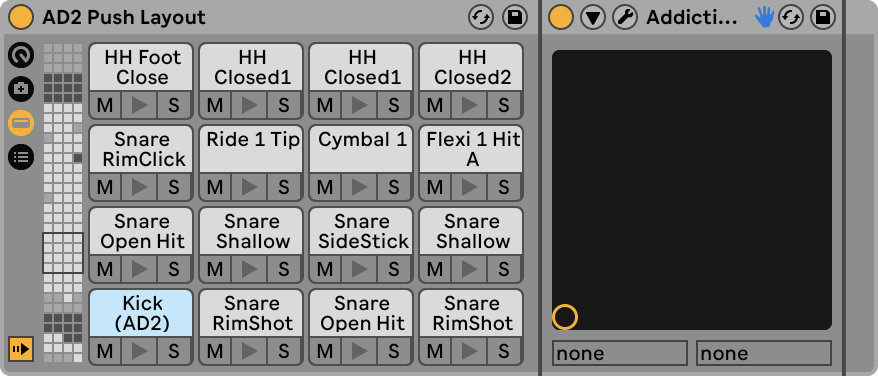
The plug-in has no kit loaded in by default. In fact, all kit pieces and parameters have been reset, enabling you to build up and configure a kit from scratch, or pick a kit to your liking. As soon as you’ve built or loaded a kit, you’re ready to start playing.
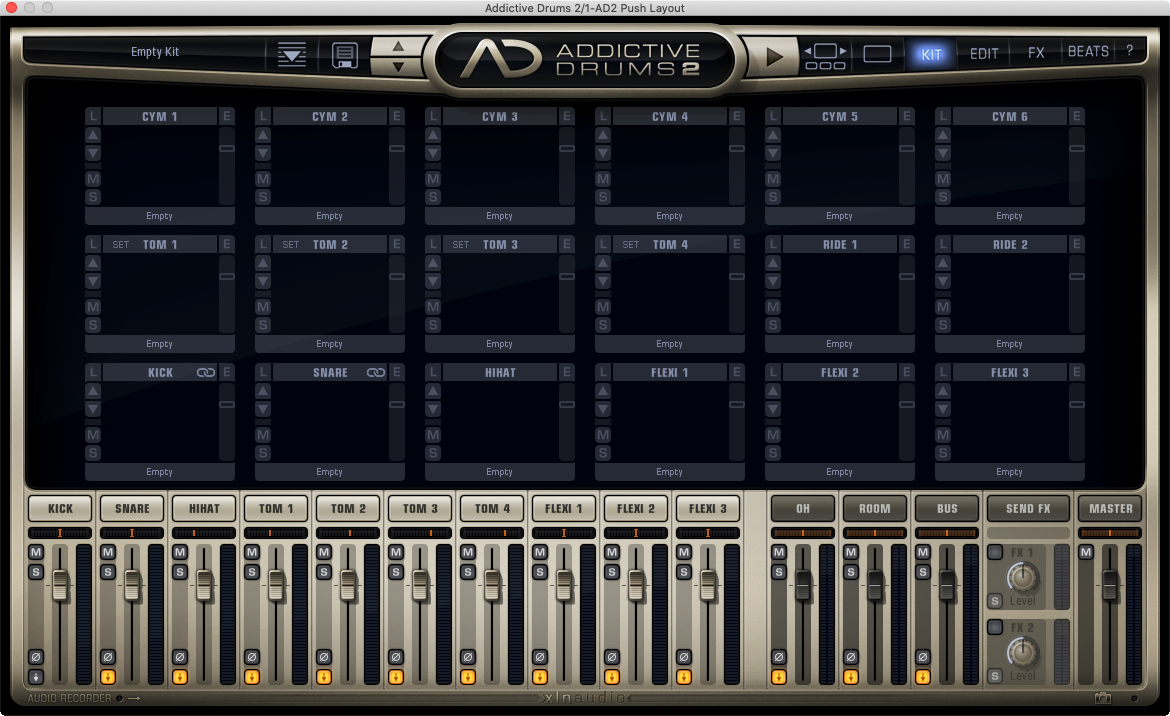
Important information:
- The plug-in format that is used for Addictive Drums 2 is VST3, so make sure VST3’s are detectable by Live.
- Only the Ghost Note Generator uses a Max for Live device: LFO MIDI.amxd. This plug-in is a modification of the Core Library LFO, allowing it live in a MIDI signal chain. The plug-in is included in the project folder.
Updates
Every now and then SoundSuite’s devices receive updates. To check if you’re still on the latest version, right click AD2 Suite’s project folder and click Show in Finder/Explorer. Once the folder is revealed, double click the www-Check For Updates.url file.

Customization
To ensure that all of AD2 Suite’s devices will work correctly, keep the map preset set to “AD2 Standard”. This map preset corresponds with the MIDI mapping of all other devices, so that means that if you want to change the mapping of the Drum Rack, you’ll have to change it for all the other devices as well. If the default map preset does not fit your taste, there is a video on YouTube where I explain how AD2 Suite works and how to make your own Drum Rack preset for Addictive Drums 2.
To access the Map Window of Addictive Drums 2, open the plug-in and click the ”?” in the top right corner of the plug-in window. Then, select “Map Window”.
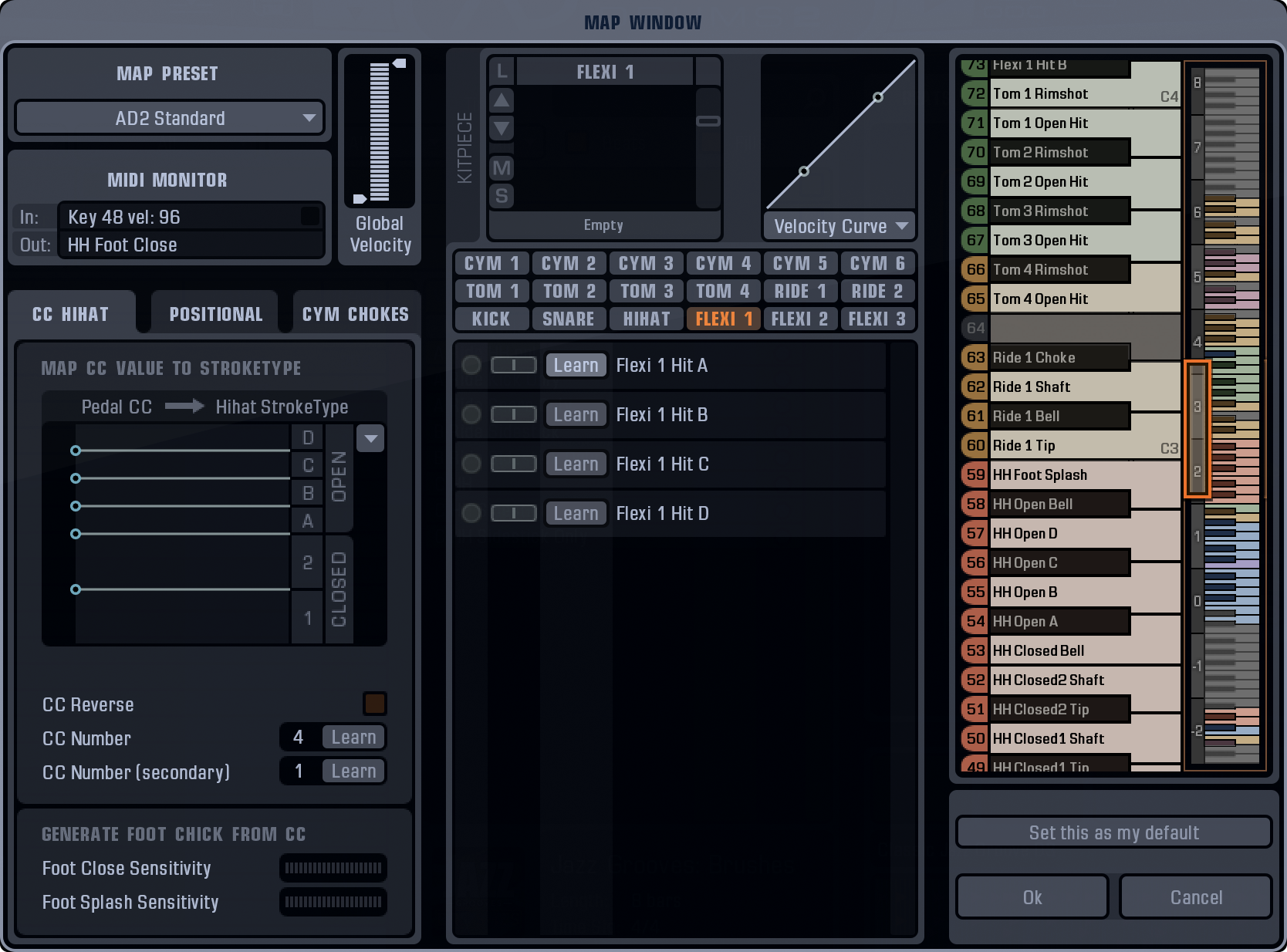
Info View and Macros
Hover over any of AD2 Suite’s Macros to reveal information about their usage in Live’s Info View.
3
AD2 Push Layout
To access the Addictive Drums 2 plug-in, click on the Kick pad inside Drum Rack.

While in the Step Sequencer mode on Push, the bottom left 16 pads offer a collection of the main kit pieces so you can easily build the main beat. Switch to the 64 Pads mode to get access to all the other drum hits that Addictive Drums 2 has to offer.
Working without Push
You don’t need a Push to be able to use AD2 Suite. Everything works like a normal Drum Rack. Once you create an empty MIDI clip, you will see a long list of all available sounds and you can draw, or record notes using any other MIDI controller.
What happens inside
By default Addictive Drums 2 has its own MIDI mapping preset called “AD2 Standard”. In order for the MIDI patterns from the Beats section inside Addictive Drums 2 to be imported correctly, a custom MIDI mapping preset had to be made that corresponds with the routing inside the Drum Rack. This is what happens in the I-O settings, which can be accessed once the Chain List is visible. From here you can see which note is played, and to which note it is redirected to trigger the right corresponding kit piece.
To further explain this process, here is an example: the Snare pad in Drum Rack – next to the kick – is triggered by C#1. This means that inside Addictive Drums 2’s Map Window a snare trigger has to be assigned to C#1 as well, and this step has to be repeated for each single Drum Rack pad/chain. Each pad (with the exception of the Kick/C1 pad, as the Addictive Drums 2 plug-in is located on this pad/chain), houses an “External Instrument” instance so that the MIDI output of the Chains can be routed back into the Addictive Drums 2 plug-in.
In the Map Window of Addictive Drums 2, on the right side you can see exactly which kit piece responds to which MIDI note.

4
AD2 Intensity Control
The top 8 macro knobs in this MIDI Effect Rack control the Drive parameters of Ableton’s Velocity MIDI effect. Intensity Control houses 16 of these Velocity MIDI effects. Each of the instances have the “Drive” knob mapped to the different kit pieces. You can automate these knobs like any other, or map them to physical knobs on a MIDI controller.
The velocity values are randomized within the margin determined by the 8 macros in bottom row. For example: if the input velocity is 60, and the Macro is set to 10, the output value for each individual note is a random number between 50 and 70. This results in a more dynamic drum sound as a larger variety of samples with different intensities are triggered in Addictive Drums 2.
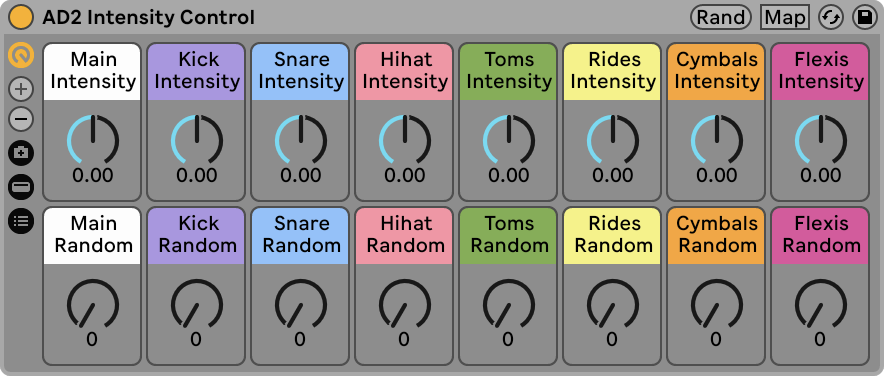
What happens inside
Once the “Show Devices” button is switched on, two Velocity effects and another MIDI Effect Rack are revealed.
- Floor/Ceiling - The purpose of this device is to raise the minimum of all incoming velocity values to 7, and lower the maximum to 120. The reason for this is that the Drive parameter only increases or decreases the velocity values when those values are not near to 0 or 127.
- Main Intensity - The Drive parameter has been mapped to the Main Intensity Macro knob, enabling you to increase or decrease incoming velocity values for all incoming MIDI notes at once. This provides control over the intensity of the entire drum kit, even if MIDI clips contain notes with velocity values close to 0 or 127, thank to the Floor/Ceiling device.

MIDI Splitter
The MIDI Splitter MIDI Effect Rack contains seven Chains. On each chain (except the Kick and Toms chains) is another MIDI Effect Rack named MIDI Notes Filter, that filters out all notes that do not correspond with the selected kit piece.
For this part, the Snare chain is used as an example: There are 4 Chains inside the **MIDI Notes Filter (Snare) **device. This is because the notes that trigger the snare are spread out over the Piano Roll, due to how the notes were mapped in Drum Rack. Because it’s not possible to split a key mapping Zone, multiple Chains and Zones had to be created. There are no devices inside the **MIDI Notes Filter (Snare) **rack. The remaining MIDI notes will pass through the Snare Velocity device of which the Drive and Random parameters are mapped to the respective macros of the MIDI Splitter rack. Those macros are then again mapped to their respective macros of the AD2 Intensity Control rack. This process is repeated for all the other kit pieces.

5
AD2 Ghost Note Generator
By default the Ghost Note Generator device does not generate any ghost notes. This is because the Max Velo(city) Macro’s have been set to 0. Increasing these values will determine what the highest possible velocity value will be for generated ghost notes, thus controlling the intensity of the added notes at the same time. The velocity values for the ghost notes will automatically be randomised slightly for a more realistic sound.
Chance Increase
As 1/24 and 1/32 ghost notes are more scarcely generated by default, opening this Macro will increase the chance that these divisions are generated.
Disperse
As the GNG generates its ghost notes using arpeggiators, a possible negative side effect is that you get a string of ghost notes, all playing in sequence. Disperse gets rid of this effect as every generated ghost note will go through a chance-based selector. The further you open the Macro, the more ghost notes will be dispersed.
Displace (Chaos)
This Macro randomises what kit pieces are triggered by generated ghost notes, thus inducing some form of chaos.
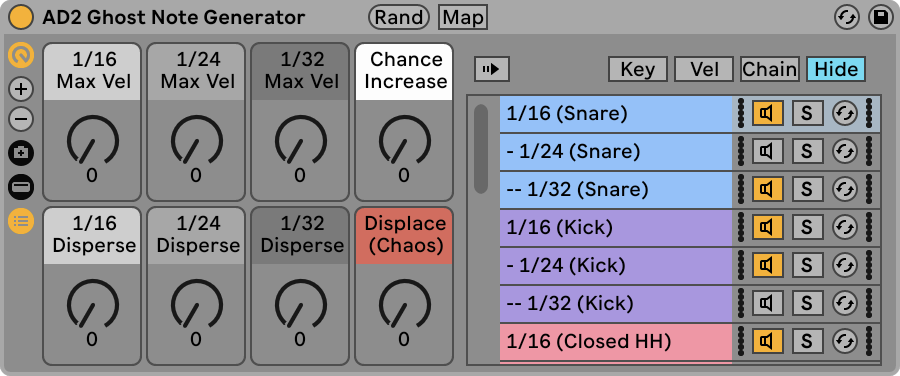
There are two factors at play which determine what MIDI notes are allowed to generate ghost notes.
- The first factor is the length of the initial MIDI notes. If an initial note is long enough so that multiple 1/16, 1/24 or 1/32 notes fit in its length, it will enable ghost notes to be generated for the duration of the initial note. For example, an initial note with the length of 1/4 has room for 4 1/16, 6 1/24 or 8 1/32 notes. Which division is generated is random.
- The second factor is whether the kit pieces and division Chains are activated or not. This can be done in the Chain List, right of the Macro Knobs. Kit pieces that are not in the list are not able to generate ghost notes.
What happens inside
The Max for Live LFO MIDI device is what is causing the randomisation. It is located in the Main Feed Chain, at the bottom of the list. The LFO modulates the Chain Selector at an a-musical rate, set to 0.64 Hertz. As the Chain Selector scrolls by, it generates 16th ghost notes all across at varying velocity values, while generating 24th and 32nd notes more rarely.
The Chance Increase Macro is mapped to the LFO’s Depth parameter. Turning the Macro narrows down the range of the Chain Selector, increasing the chance to generate 24th and 32nd notes for all enabled kit pieces. The LFO’s Rate also increases slightly as the Chance Increase Macro is turned clockwise.
Inside the chains
All Chains but the Dry Chain contain an Arpeggiator with the Rate matching the Chain’s name. Whenever the Chain Selector scrolls by a Chain’s Zone, it are these arpeggiators that generate the ghost notes. Behind each Arpeggiator are three Velocity MIDI effects:
- Velocity Randomizer: sets the velocity value for all generated ghost notes to 64, and then fully randomises it between 0-127.
- Velocity Disperser: only lets through MIDI notes with a velocity value that falls within the allowed range.
- Velocity Max: determines the max output velocity value for the ghost notes, and slightly randomises the values for more realism.
Displace (Chaos)
This Macro is mapped to the Steps parameter of every Arpeggiator in GNG. The Distance parameter of the arpeggiators is set to +2 semitones. This means that for every generated ghost note (with the exception of the first ghost note), will be pitched up 2 semitones. The process re-triggers with every new initial MIDI note. Therefor, Displace (Chaos) has a stronger effect on long initial MIDI notes, especially 1/24 and 1/32 divisions, as they generate notes more frequently.


6
Using and forwarding Send / Return Channels
The Push Layout device contains 3 internal send/return channels. No effects have been loaded into them yet. You can either choose to keep them to work internally and use effects for the drumkit alone, or you can forward the audio signal to the project’s main return channels. To do this, with the Chain List open, click on the I-O icon. Open the Return channels with the R icon. Now that the Return channels are in view, with the output menu on the right you can select to which Return channel you’d like to forward the signal. If you need more or less Return channels, it is safe to add or delete them. It won’t affect anything or require any additional setup.

7
LFO MIDI Workaround
If you do not own Max for Live, this means that the Chain Selector inside the Ghost Note Generator is not modulated as the LFO MIDI device is disabled. To counter this, modulation will have to be hand drawn inside an existing MIDI clip. An example is present in the “Basic beat” clip in the presets labeled “Without Max for Live”. Here’s how to do the workaround yourself:
- Open the Envelopes Box in the Clip Editor. In the Device Chooser menu, select AD2 Ghost Note Generator. In the Control Chooser, go for the Chain Selector, which is listed at the bottom.
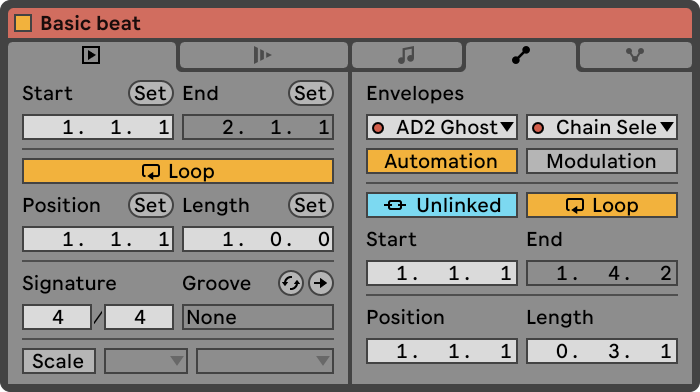
- Next, unlink the Envelope from the MIDI clip and set the duration of the envelope to an a-musical length.
- Finally, draw the Envelope in a sawtooth fashion. Start at the minimum, and end at the maximum.

The Chain Selector now has a red dote next to it, showing that it is now automated. Once you trigger the clip, the Ghost Note Generator will now generate ghost notes as intended.
Because the Chance Increase Macro is mapped to the LFO’s Rate and Depth parameters, this Macro will be disabled when Max for Live is not installed.
8
Changelog
V2.0 (November 30, 2022)
- AD2 Suite now uses the VST3 variant of Addictive Drums 2.
- AD2 Suite now requires Live 11.2.
- The Addictive Drums 2 plugin now uses the “AD2 Standard” mapping.
- The Intensity Control and Random Control devices have been combined into one, resulting in far less devices being used, and improving responsiveness of Live with larger Live Sets.
- Updated some of the colors used throughout AD2 Suite.
- Updated the online manual.
V1.5.3 (June 22, 2020)
- Updated the included LFO MIDI plug-in.
V1.5.2 (October 11, 2019)
- Reintroduced automation examples in every Basic Beat clip in the (without Max for Live) project.
- Optimized both Intensity Control and Random Control devices, resulting in a smaller number of total devices.
- Removed 4 scenes from both project files.
- Updated the online manual’s AD2 Intensity Control device chapter in regard to the new changes.
V1.5.1 (October 3, 2019)
- Repackaged download file format to Ableton Live Pack (.alp). The new file contains two project files serving as presets, the LFO MIDI.amxd file and URL files that lead to the online Manual, Changelog and Update Checker.
- Added info texts to all of AD2 Suite’s Macros. Hover over the Macros to read info about them in the Info View.
- Updated the online manual’s Installation chapter in regard to the new changes.
V1.5 (May 29, 2019)
- AD2 Suite now supports the Beats section inside the plug-in. When importing a MIDI pattern into Live, the mapping will be correct, unlike in previous versions. To achieve this, a custom MIDI mapping preset was added to the Addictive Drums 2 plug-in. When opening the Map Window in the plug-in, the name of the preset is displayed as “unknown”.
- The routing inside the AD2 Push Layout device has been changed to match the new MIDI mapping.
- Added one new Velocity effect to the AD2 Intensity Control device: “Floor/Ceiling”. For all incoming MIDI notes it raises the minimum velocity value to 7 and lowers the maximum value to 120. This ensures that the Drive parameters on the other Velocity devices WILL have an influence on all MIDI notes, while in previous versions this was not the case whenever notes had velocity values close to 0 or 127.
- Updated the online manual’s Installation, AD2 Push Layout device and AD2 Intensity Control device chapters in regard to the new changes.
V1.4 (February 28, 2019)
- For GNG, the Macros for Max Velocity and Random Velocity have been combined into one Macro for all three note divisions. The maximum random velocity for ghost notes is calibrated to 32 (above and below the maximum value).
- For GNG, The Chance Increase and LFO Rate Macro’s have been combined into one single Macro.
- For GNG, added new feature: Disperse. Opening the Disperse Macro’s will make generated ghost notes disperse across the duration of the initial MIDI note. It also makes it possible to use much longer MIDI notes. This way the ghost notes feel more impulsive, and less arpeggiated.
- For GNG, added a new feature: Displace (Chaos). Opening this Macro will add steps of +2 semitones in the arpeggiators that generate the ghost notes, resulting in unintentional kit pieces being triggered instead of the just the initial note’s corresponding kit piece.
- For GNG, reorganised and removed redundant devices in the primary Chains.
- In the project file without Max for Live, the Basic Beat clip now has the Chain Selector of the GNG automated by default to illustrate an example.
V1.3.1 (November 9, 2018)
- Added a second project file with presets for users who do not own Max for Live, as V1.3 wouldn’t load on Live Standard.
- Updated the online manual’s Installation chapter in regard to the new presets.
- Fixed a broken link in the attached Readme PDF.
V1.3 (April 8, 2018)
- For GNG: rearranged the Chain List.
- For the main Mixer in the Session View: all levels are now defaulted to 0dB.
V1.2 (March 29, 2018)
- For GNG: added Kick Chains for each division.
- For GNG: divided 1/16 (All) Chain into separate chains for similar functionality to the 1/24 and 1/32 chains.
- Updated the online manual’s Ghost Note Generator chapter in regard to the new features.
- Fixed some bugs in GNG.
V1.1 (March 20, 2018)
- Instead of 1 single Drum Rack channel, the AD2 Suite project now contains 3 channels/presets for AD2 Suite. One with all channels set to Pre-Fader outputs, one with Post-Fader outputs, and one Stereo channel preset.
- Updated the online manual’s Installation chapter in regard to the new presets.
- Minor audio routing bug fixes.
V1.0 (March 1, 2018)

